Keynotes Bizagi Virtual October Event3rd of December 2017 |
 |
October 26 marked the Bizagi Virtual Event titled “The Rise of the Intelligent Business”. An event that focused on how AI and RPA will influence Business Process Management in the coming time. The event had three speakers that came to share their view in a typical Webinar style, and introduced me to some interesting perspectives on how these technologies and concepts will take center stage. Since Nathaniel Palmer at BPMNext 2017 listed Automation as one of the key concepts to look out for in the coming years, these webinars seemed like a logical place to further my knowledge on the subject. The three speakers were Craig Le Clair (Forrester Research), Alan Hester (Nividous Software Solutions) and Frank Beyer (BPM consultant).
First up was Craig Le Clair and his take on the Intelligent Customer Experience. As we look at the Customer Journey by Forrester Research, it exists of several phases, of which the last one is to Engage a customer in helpdesk style. This is where he believes AI components are still focused on. As a reference, I’ve put Forrester Research’s Customer Lifecycle in a diagram underneath, together with comparable models from Capgemini and I-Scoop. These AI used for customer support are joined by the virtual advisors to help employees in their operational work. Both has grown out knowledge harnessed during the evolution of spam bots, personal assistants (Siri and the like), and chatbots with limited responsiveness.

Customer Lifecycle Models
Ideally, we enhance the 3 capabilities of the robotic paradigm equally (sense, think and act) for such AI components to grow emotional recognition patterns in order to complement them with a proper human escalation protocol. This means they should be able to detect when they are out of their depth, and should transfer the call to a human agent. I do like how we always state that AI should break away completely from how human do things and try to learn on their own with bias of past human experience, and then I see the robotic paradigm being a compressed from of the OODA-loop, which we want humans to follow for decision making.
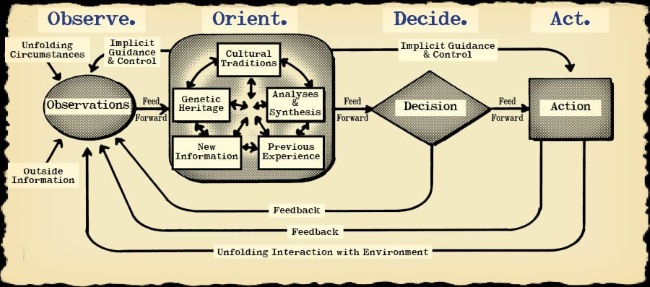
OODA Loop
Alongside AI comes Robotic Process Automation (or RPA) to mimic the mechanical/manual actions we as employees perform every day, like clicking buttons or performing other such menial/monotonous tasks. Delegating these to a machine has been the preoccupation since the model T cars rolled off the conveyor belt, or even earlier during the industrial revolution with the introduction of the industrial loom. All of these culminating in the interaction between machines and AI, from automated plants and trade rooms to domotics and the Internet of Things.
The second keynote speaker, Alan Hester of Nividous Software Solutions, expands on this topic with his insights on the business case for RPA. Similar to past initiatives (Micro Services, Service Oriented Architectures, ERP and CRM solutions…) the two considerations are always increase of revenue and reduction of costs. He dubs the monotonous tasks ‘swivel chair processing”, which is a catchy way of saying humans switching from one application to the next in order to complete a process. He also identifies two additional areas where RPA will play a major role: integration with legacy systems and support for audit/regulatory requirements. On top of the two benefits stated at the beginning of this paragraph, he adds better management and visibility. In short, the introduction of robots will make the process faster, more accurate, add to productivity (a robot needs no rest), and allow for better scaling. Again, I see why these benefits are stated, but these are still the same benefits stated since the beginning of the Taylor method.
When he argues that it gives the company an easy way to scale up in peak periods, he does warn about the change management aspect associated with this. The issues/risks that arise are not linked to the technology (it will do whatever is needed), but rather stem from the impact on the organization and the people in it. But employee satisfaction will go up when RPA takes over the monotonous, repetitive tasks of employees, so they can focus on the interesting part of their jobs.
The third keynote was presented by Frank Beyer, a Business Process Consultant, and was for me the most interesting. Where the previous two gave us an overview of the market and developments, the third keynote went into detail on how to tackle projects introducing RPA on the one hand and Cognitive Processing Automation (CPA) on the other hand. He indicates that RPA and CPA are at opposite ends of the spectrum, using Bloom’s Taxonomy of Cognitive Skills as the reference. CPA works on those tasks at the top of the pyramid, while RPA focuses on the bottom. These two disciplines are however growing towards each other to meet and cross in the middle (application).
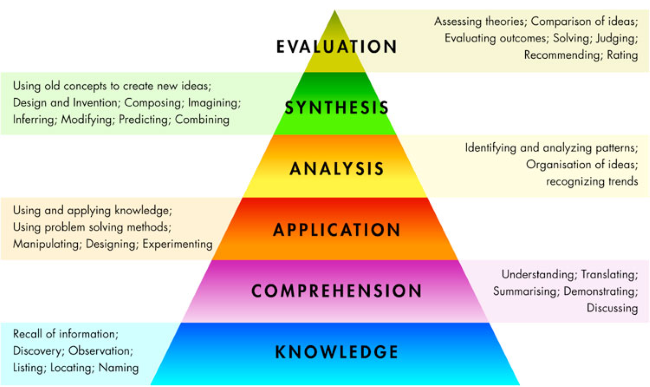
Bloom’s Taxonomy of Cognitive Skills
While RPA seems to have taken a hold in the world of automation, CPA is has some ways to go. Beyer refers to this as the cognitive barrier. Most companies has achieved (or at least made great strides towards) a paperless office, and the interconnection of systems has a similar track record within those companies. When it comes to digitizing human activities, only RPA is being considered with any seriousness. Artificial Intelligence, Cognitive Technologies and Data-Driven Decisions are nice to haves, but no plan or strategy about them is yet clearly formulated.
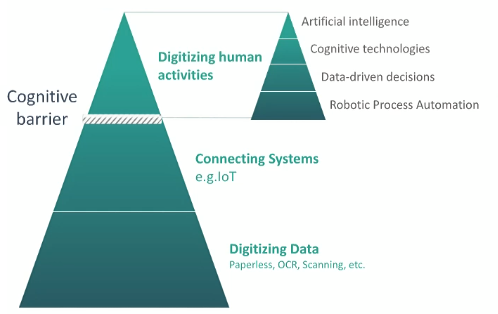
Cognitive Barrier
To position RPA and CPA in the world of BPM (or more accurately in its process automation strategy), we look at the diagram below. If we divide up the BPM tool functionality in the standard three layers of the N-tier architecture, we see the setup on the left side. RPA automates human tasks, so it will be situated in between the business layer where the workflow is orchestrated, and the presentation layer where the knowledge worker would normally execute these tasks. CPA takes its place cross-layer, with the AI steering decisions being made on all levels, as well as real-time optimization strategies, such as machine learning.
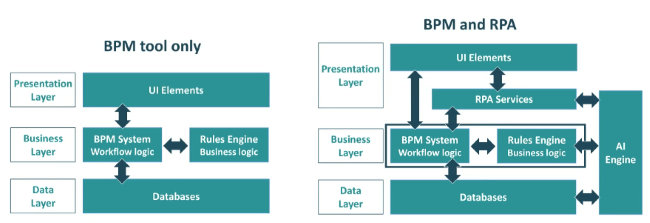
It could seem from this diagram that RPA is just replacing the synergy BPMS/SOA, where these human tasks were switched out for services taking care of the integration with the process flow. We could ask ourselves whether RPA is indeed a new development, and not just SOA in a new wrapping. Add to this the main criticism for RPA in that it does not present a solution as robust as embedding these automations in the core systems (for example by using services). I like the view that Hans-Christian Grung-Olsen (consultant for Capgemini Norway) has on this particular train of thought. He sees RAP not as a replacement of SOA, but rather as a way to innovate. We achieve this by using RPA as a prototyping tool with fast iterations in order to get a minimal viable product as quickly as possible. Once it is running, business can then evaluate whether to discard the RPA, replace it by a more stable SOA solution, or to leave them as RPA if its value does not warrant the development of a SOA solution. This is shown in the RPA lifecycle below.
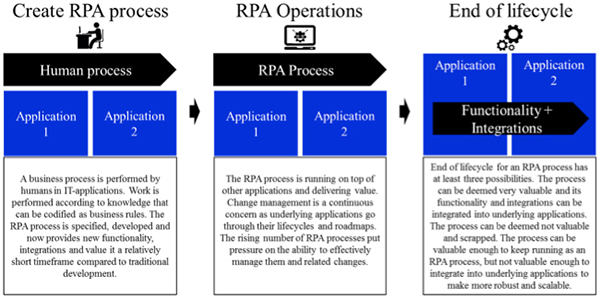
The benefits of digitizing the cognitive activities are fivefold, as summed up by Beyer. It does seem to me that most of these benefits do not really come from CPA, but rather of the preparatory process that renders your enterprise ready for CPA. I would like to have seen a bit more focus on the benefits from the final stage of CPA implementation. The stated benefits are as follows:
- Tacit knowledge becomes transparent and validated.
- Reduced heterogeneity by removing bias and individual, undocumented/unofficial rules.
- Clarity of data is needed so that unstructured data (such as big data) will become more structured.
- Accelerates system integration to feed digitization with data located in other systems.
- Fully automated processes can be used as a platform to connect to customers and partners.
Beyer’s approach for implementing a CPA project consists of 4 stages. The Translate stage consists of transforming the identified rules to logical units, to be implemented as software in the stage after that. The latter two stages don’t require that much detailing to get a firm grasp on how to proceed with them. The first two stages have a bit more elaboration during the keynote.

The Observe Stage is where the selection criteria are determined. When looking at all candidates for CPA or RPA implementation, we need to decide which of these tasks should be tackled first. Beyer suggest some primary criteria, such as labor intensity, susceptibility to human error, process frequency, and the level of knowledge required. Secondary criteria could be utilization of available knowledge, data intensity, extent of non-digital data, fragmentation of data and divergence of process outcome. He has extended on this in an article (published on SlideShare).
In the Identify & Analyse Phase, we take the selection criteria and apply them to the known tasks in the processes of the enterprise. For the chosen candidates, their aspects are charted so that the translation stage can easily draft up the logical units. Some possible aspects (almost in a SIPOC mindset) are:
- Business Rules: Which tasks are executed, how, when and under which circumstances?
- Tacit Knowledge Applied: What knowledge is required from the knowledge worker that is not yet documented/automated?
- Input Data: What data is needed to complete the task?
- Output Data: What data is generated by executing the task?
- Historical Process Data: Is historical process available mapping input to output data? We can use this to determine how reliable our process is.
| Review | BPM | SOA |